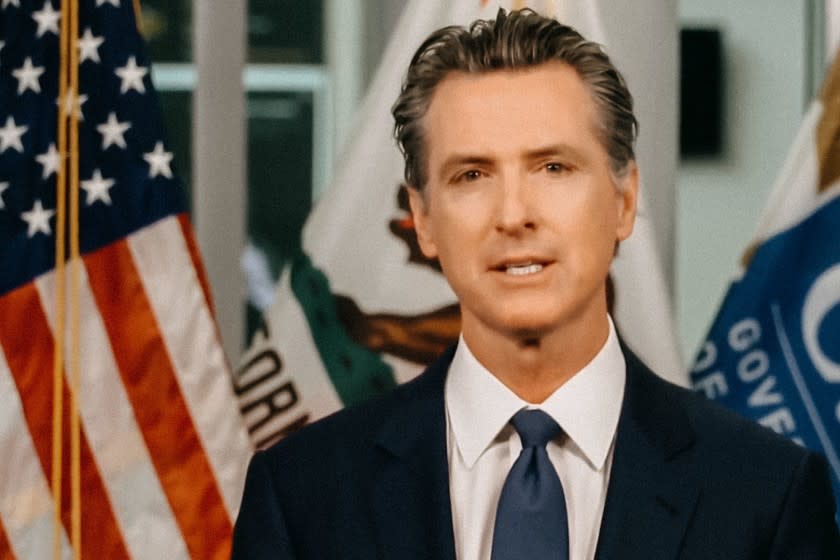Skelton: Newsom proves he's no deer in headlights while managing several crises 'of biblical proportions'

Gov. Gavin Newsom has been keeping barely one step ahead of being trampled by rampaging disasters.
He has survived on energy and agility — and hasn’t frozen like the proverbial deer in headlights.
Last fall, I wrote it was unlikely that any previous California governor had faced such a simultaneous cannonade of calamities. At the time, there were devastating wildfires and power blackouts in Southern and Northern California.
Now wildfires and blackouts are piled on top of a COVID-19 pandemic — a strange virus that has infected more than 680,000 people and killed more than 12,000 in California. You’d think that might place any governor at political risk, but it apparently hasn’t.
And with the killer virus came a crippled economy, home confinement and school closings — plus frustrating lifestyle inconveniences such as the absence of indoor dining and cancellation of fall football.
“Newsom has been hit by plagues of biblical proportion,” says Garry South, political strategist for former Gov. Gray Davis, who was recalled in 2003 after California suffered an energy crisis caused mainly by Texas power pirates — mostly Enron. The pirates held back electricity in order to drive up the kilowatt price, resulting in brownouts all over the state.
Davis looked to voters like that deer in headlights.
“But we didn’t have a pandemic going on and a tumbling economy — and wildfires burning down half of Northern California.” South says. “I don’t know how you deal with all that.”
“California is being tested right now in an unprecedented number of ways, and the governor is working nonstop day and night to make sure California is meeting the moment,” Newsom spokesman Nathan Click says, echoing one of his boss’ favorite, overused phrases: “Meet this moment.”
California governors have always been tested by natural disasters — none more so than Pete Wilson in the 1990s.
Unlike Newsom’s plight, Wilson’s disasters didn’t all come at once. But he was smacked with a barrage of cataclysms: earthquake, flood, drought, wildfires, the L.A. riots and an economic slump that required the Republican governor to uncharacteristically fight for the largest state tax increase in history.
Wilson earned kudos for his swift handling of the disasters — especially his getting Southern California freeways up and running ahead of schedule after the 1994 Northridge earthquake. It helped him win reelection that year.
Gov. Pat Brown committed perhaps the all-time worst verbal gaffe during a catastrophe. While inspecting a horrible 1960s North Coast flood, he proclaimed: “This is the worst disaster since I was elected governor.”
Brown, who had a wonderful sense of self-deprecating humor, laughed about that for years afterward.
Despite the pandemic that’s almost into its seventh month, plus the tattered economy, huge wildfires and blackouts, Newsom, 52, is surviving politically. You don’t hear many people shouting his praises, but they’re not throwing rocks either.
And that’s good enough for now.
“He’s been doing OK, doing pretty well” says South, who was briefly a Newsom campaign strategist in 2009 when the then-San Francisco mayor contemplated running for governor. Jerry Brown jumped into the race, and Newsom wisely dropped out, running instead for lieutenant governor, the launching pad for his 2018 gubernatorial election.
“His reopening the bars and nightclubs too soon was a big mistake,” South says. “Restaurants are one thing. People have to eat to live. But they don’t need to drink to live. If they do, they can go to Ralphs and get a six-pack.”
Newsom soon closed the bars again after the virus began spreading among patrons.
“Having said that,” South continues, “I’ll defend Newsom in this sense: With 40 million people living in California, it doesn’t matter what kind of pandemic is going on. You can’t keep that many people as hostages in their own homes forever. They go stir crazy. It’s not the nature of human beings to submit to that.
“Did he reopen too soon? I think he did. But he was between a rock and a hard place in the real world. He was trying to balance off public health concerns with a recognition of human nature.”
Newsom deserves and gets credit for trying lots of things, even if some of them didn’t work.
On Wednesday, the governor announced a plan to double the state’s COVID-19 testing capacity, obtain much swifter results and substantially lower patient costs. Great. It’s just too bad he didn’t come up with that weeks ago.
And Newsom isn’t hiding. He holds regular televised news briefings on coronavirus and wildfire happenings.
The governor rambles, is repetitive, is too long-winded and gets bogged down in numbers and weeds. But the briefings come across as unprecedented good-faith efforts at transparency. That is sorely lacking in government, and Newsom deserves applause.
It’s unlikely any of the governor’s disaster managing will affect him much politically — unless he really screws up or finds a COVID-19 cure.
People are so politically polarized that their views are largely unmovable, says Mark Baldassare, president and pollster of the Public Policy Institute of California.
“I’ve been struck by how in polls you don’t see approval ratings moving around a lot,” Baldassare says. “That’s because so many people have made up their minds about who they believe and trust and who they don’t. Fewer people are willing to change their minds.
“They’re so polarized.”
Also protecting Newsom in California is a weak Republican Party that is incapable of mounting a serious challenge when he runs for reelection in 2022.
Newsom is keeping slightly ahead of the disasters — and any potential political rivals aren’t even close.

